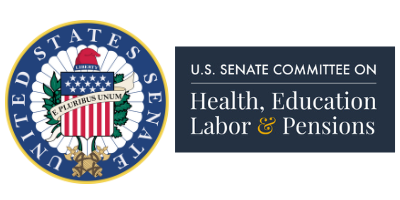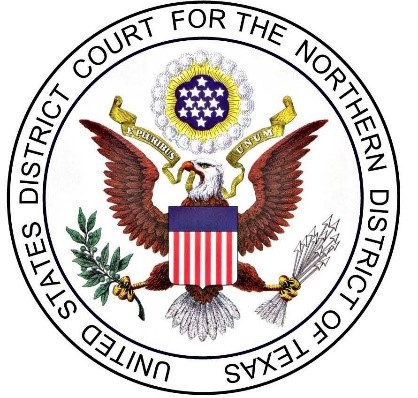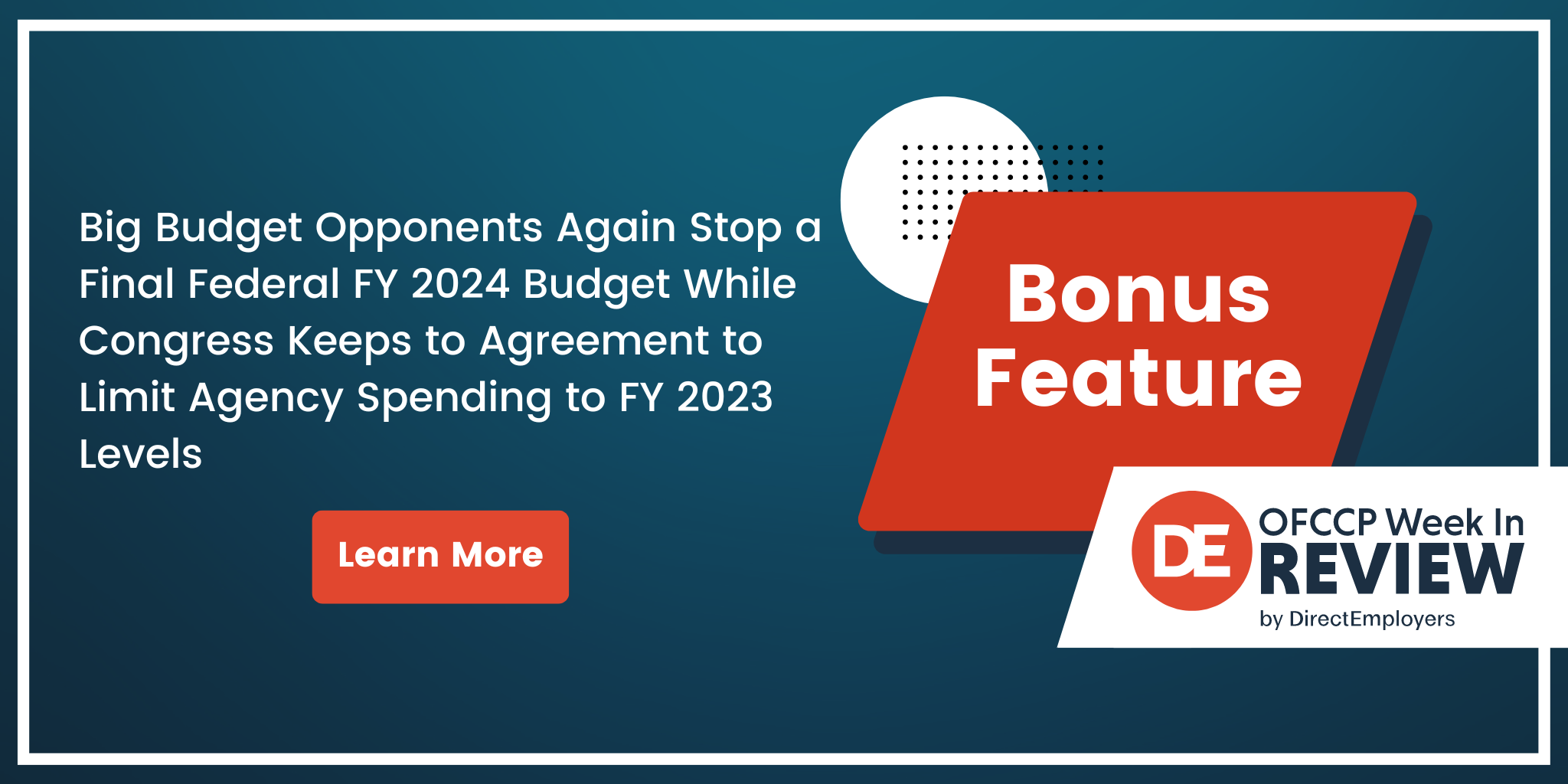
- U.S. OPM & OMB Jointly Published First Ever Strategic Plan on Hiring Military Spouses
- Senate HELP Committee Advanced Renomination of Julie Su To Be Next U.S. Secretary of Labor
- DE Talk Podcast Discussed “Platinum Rule of DEI”
- DirectEmployers Named #1 in Government Contracting in JD Supra 2024 Readers’ Choice Awards
- Big Budget Opponents Again Stop a Final Federal FY 2024 Budget While Congress Keeps to Agreement to Limit Agency Spending to FY 2023 Levels
- In Brief
- New Publications
- Looking Ahead: Upcoming Date Reminders
Tuesday, February 27, 2024: U.S. OPM & OMB Jointly Published First Ever Strategic Plan on Hiring Military Spouses
Plan Covers Fiscal Years 2024-2028
It Addresses Service-Related Challenges for Families

“A good-paying, flexible, and dependable federal job strengthens the economic security of our military families and helps spouses succeed in their own careers, while also supporting their loved ones in uniform,” observed OPM Director Kiran Ahuja in an OPM press release.
“This Strategic Plan will help ensure that our military and veteran families, caregivers, and survivors have the opportunity to build meaningful careers and economic security for their families – while strengthening our federal workforce,” added Jason Miller, OMB Deputy Director for Management.
Executive Orders Behind the Plan
On June 9, 2023, President Biden issued EO 14100, titled “Advancing Economic Security for Military and Veteran Spouses, Military Caregivers, and Survivors.” To ensure that the federal government is an employer of choice for these groups, the EO directs Executive Departments and agencies to strengthen their ability to recruit, hire, develop, promote, and retain this skilled and diverse pool of talent. Section 2 (a) calls for the OPM Director and the OMB Deputy Director, in consultation with the Secretaries of State, Defense, Labor, Veterans Affairs, and Homeland Security to develop and issue a government-wide hiring and retention strategic plan for these groups.
In its press release, OPM explained that “[t]his Strategic Plan also builds on the government-wide plans required by EO 13583 of August 18, 2011, which established a coordinated government-wide initiative to promote diversity and inclusion in the federal workforce, as well as EO 14035 of June 25, 2021, which advances diversity, equity, inclusion, and accessibility in the federal workforce.”
What’s In the Plan?
The Strategic Plan has three goals:
- Eliminate Employment Barriers and Strengthen Military-Connected Families’ Access to Agency Programs (pages 7-10);
- Increase the Number of Military-Connected Family Members Serving in the Federal Government (pages 11-13); and
- Create Workforce Development Opportunities to Support the Sustainability of Military-Connected Employees (pages 14-17).
Also included throughout the plan are:
- Measures of success for the recruitment, hiring, and retention of military-connected spouses;
- Enhanced support for the retention of military spouses in federal careers;
- Strategies to eliminate, where applicable, barriers to the employment of military-connected spouses in the federal workforce;
- Strategies for marketing the talent, experience, and diversity of military-connected spouses to agencies; and
- Data-driven approach to increasing transparency and accountability in hiring and retention – including by encouraging agencies to set goals for hiring under the Military Spouse Noncompetitive Appointment Authority.
See also our recent, related news report and DE Talk Podcast.
Also, let the record show that at the time President Biden was unloading his Executive Order on Military Spouse hiring and retention, DE had already scheduled its March 21, 2024, Masterclass Roundtable to discuss how employers might construct an outreach and recruitment plan aimed at Military Spouses. Somebody was reading somebody’s mind.
Tuesday, February 27, 2024: Senate HELP Committee Advanced Renomination of Julie Su To Be Next U.S. Secretary of Labor

Just as with her previous nomination, the Committee vote was split 11-10 along party lines. Ms. Su has been the Acting Secretary of Labor since former Labor Secretary Marty Walsh left the Department of Labor on March 11, 2023 in a huff over President Biden’s failure to select Secretary Walsh to be the President’s new Chief of Staff when that position suddenly opened up. We previously reported that, on January 8, President Biden formally sent the renomination of Acting Secretary of Labor Su to the U.S. Senate.
Following Tuesday’s vote, Senator Bill Cassidy (R-LA), Ranking Republican on the HELP Committee, released a statement protesting the closed-door nature of the meeting and again expressing the concerns that he, and other Republicans, have about Acting Labor Secretary Su’s background.
The next stop for Su’s nomination following the Help Committee’s action is for the full United States Senate to, again, consider her nomination. Senate Majority Leader Schumer will decide whether and when he might seek to advance her nomination to a full Senate Floor vote. Majority Leader Schumer will not do so, of course, unless and until he has counted votes and knows he has a majority of those Senators voting on any given day the Senate is in session willing to vote in favor or her nomination.
This is a tall order given that Su’s nomination the last time around the block drew the opposition of all 49 Republican Senators and at least two Democrats and two Independents (who caucus with the Democrats), including two who publicly voiced their opposition: Senators Manchin (I-WV) and Sinema (I-AZ). With Democrats and Independents holding 51 Senate votes, Majority Leader Schumer can afford to lose only two Democrat and/or Independent Senatorial votes if all Senators vote and Republicans again offer a united opposition of all 49 of its Members.
President Biden’s strategy in renominating Su for the position after her earlier historic rejection of a proposed Cabinet Member may be to pick up additional Democrat Senatorial votes as 20 Democrat Senators head into re-election battles in November. President Biden’s calculus may be that a number of the “fence-sitting” Democrats and liberal Republicans may need Labor Union support in November (which is very strong for Su, an ardent watercarrier for unionists). Union pressure supporting Su would have to change the minds, however, of at least three opposition Democrats and/or Independents and/or liberal Republicans.
Alternatively, Senator Schumer would have to strategically pick a Senate Legislative Day where he could muster enough favorable votes while two or more Republicans were out of position and unable to appear on the Floor of the Senate to vote (due to overseas assignments, illness, vacation, or pressing business back in their home state).
Remember, it is a “majority” of those Senators voting that counts (and the Quorum Clause of the U.S. Constitution and U.S. Senate Rules do not allow “remote” votes). For example, see the story, below, reporting on a case decision rendering the new Pregnancy Workers Fairness Act unconstitutional in Texas for the very reason that the House momentarily allowed remote voting (during the COVID-19 pandemic), including on the PWFA.
If Senators Manchin and Sinema were to vote against the Julie Su nomination, and if all other 49 Democrats and Independents were to vote in favor of her nomination, and Republicans could drag, push, shove, or wheel in on a medical gurney only 48 of their 49 Members onto the Senate Floor, Su’s nomination would still fail to attract a “majority” of voting Senators: 49 Yeas; 50 Nays; 1 absent.
However, if any other Democrat or Independent Senators were to join Manchin and Sinema in their suspected coming oppositions to Su’s renomination, Majority Leader Schumer would need to offset each loss of a “Yea” vote. Schumer can do so either by persuading a liberal Republican Senator to defect and vote for Su or pick a better day to host the vote when two or more Republicans might be unable to slide into the Senate on time to vote. (We are sure Senate Minority Leader Mitch McConnell’s office is daily scouring the travel logs of Republican Senators on overseas trips on behalf of the Senate to make sure they are paired one-for-one with Democrat Senators on the same trip or are declining trips due to the “pressing needs of the United States Senate.”)
And please remember that there were two Democrats rumored at the time of Su’s first trip through the Senate to be “in the shadows” and in opposition to Su’s nomination but who did not wish to go public with their opposition. Of course, they did NOT need to go public with their oppositions since Manchin and Sinema were “on the public record” against the nomination and that was enough to kill it. Presumably those two additional “Nay” votes have not changed (unless Senator Schumer has found some ways to flatter those holdout Democrats sufficiently to cause them to change their votes).
On the other hand, President Biden may have sought to merely reassure Asian voters (60% of whom currently vote or lean Democrat) by giving Su the opportunity to remain in office with her head held high that her “nomination was pending” should this Congress end on January 2, 2025, without Majority Leader Schumer bringing Su’s nomination to a full Senate Floor vote.
On another hand, President Biden may have thought that portraying Julie Su as a “political martyr” – a modern day “Joan of Arc” being burned at the stake by harsh Republicans who are punishing her only for being obedient to an inner voice driving her to dedicate her life to help the Union movement – would help him win Blue Collar votes in November. Perhaps Julie Su is also part of the White House’s re-election plan to galvanize union members to get out the vote. Or perhaps the White House is hoping Su’s message of extending her hand to help the downtrodden in our society will appeal to more “working men and women” to help shore up the President’s waning support from Blue Collar workers as he heads into the November Presidential election.
By the way, was Marty Walsh’s Nomination to be a Governor of the United Sates Postal Service, discussed immediately below, merely coincidental or part of a broader push for the union vote against a likely election run against former President Trump. Trump, of course, won strong support from Blue Collar voters in each of his two prior Presidential election runs. Also, wait for Democrats to argue in Su’s nomination fight that “what is good for the goose is equally good for the gander” as they contrast Marty Walsh’s aggressive support of unions while the Secretary of Labor with the equally aggressive positions Julie Su has taken coming along behind Walsh at USDOL and which positions have drawn vigorous criticism from Senate Republicans.)
Remember: any decision made in any White House is always made by asking the question: “Does this decision win us more votes than it loses”?
Put aside your Netflix and Amazon Prime Memberships for the rest of the year: you have enough free entertainment coming your way in this coming Presidential election for any two-year stretch of TV-watching! (Could even rival Mrs. Maisel (even better than S5:9) and The Bear (S2:7))!
Sidenote: Former Secretary Walsh May Take on U.S. Government Service Side Hustle
As WIR readers may recall, when Secretary Walsh left the Labor Department in March 2023, he took the position of National Hockey League Players’ Association Executive Director. Secretary Walsh may be returning to federal government service, at least as a side hustle. This past Thursday, February 29, President Biden sent to the Senate his nomination of former Secretary Walsh to be one of the nine Governors of the United States Postal Service (“USPS”) for a term expiring December 8, 2029. USPS Governors earn $30,000 per year and qualify for per diem (if they spend more than 42 days per year in the service of the company) for a largely ceremonial position and to insert political influence on what is the equivalent in other corporate contexts to a Board of Directors.
Tuesday, February 27, 2024: DE Talk Podcast Discussed “Platinum Rule of DEI”
Studies show that diverse teams who feel safe to contribute in a meaningful way outperform teams who don’t have that same level of diversity. The question is, are you truly doing everything you can to get the most out of your people? Tune in to Episode Eight of the DE Talk Podcast as Andrew Adeniyi, Author, CEO and Founder of AAA Solutions, and first-generation Nigerian American, discusses the three Ps of creating a diverse, inclusive, and equitable culture in the workplace. Andrew also shares his insight on the importance of belonging and how it plays a role in employee engagement, satisfaction, and turnover, as well as how the “platinum rule” of DEI has the potential to change the way we view diversity.
Listen to our DE Talk Podcasts via any of the options below and subscribe to receive updates whenever a new podcast is available.
Apple • Spotify • Google • Stitcher • iHeartRadio • Stitcher • TuneIn • Overcast • Pocket Casts • Castro • Castbox • Podchaser • RSS Feed
…or your preferred Podcast provider!
Monday, March 4, 2024: DirectEmployers Named #1 in Government Contracting in JD Supra 2024 Readers’ Choice Awards
For fourth consecutive year, DirectEmployers’ authors topped Government Contracting category of JD Supra

JD Supra’s Press Release announcing this news is here.
DE’s Press Release announcing this news is here.
Candee Chambers, Executive Director of DirectEmployers Association, CEO of Recruit Rooster, and Editor/Writer of the Week in Review wishes to also thank the Week In Review writing and publishing team for their unrelenting efforts at excellence and to timely deliver the news to the WIR’s International and domestic readers each Monday afternoon at 3 pm EST. Thanks go to Cynthia L. Hackerott, Esq., where it all starts each week, John C. Fox, Esq., Jay J. Wang, Esq. (an occasional contributing reporter), Jaime Costilow, and Kacie Koons.
Friday, March 1, 2024: Big Budget Opponents Again Stop a Final Federal FY 2024 Budget While Congress Keeps to Agreement to Limit Agency Spending to FY 2023 Levels
US DOL Budget Will Remain at its Present Level Through March 22, 2024

The delay to agree upon final budgets for the remaining seven-months of Fiscal Year 2024 (ending September 30, 2024), continues to be how…
In Brief
Monday, February 26, 2024: Release of 2023 EEO-Component 1 Reporting Instruction Booklet & Data File Upload Specifications Expected by March 19

Historical Context
By way of comparison, the EEOC opened its 2022 EEO-1 Survey Component 1 Data Collection on October 31, 2023. Following a deadline extension (from December 5, 2023), the 2022 reporting period eventually closed on January 9, 2024. (That is why it seems like we just did this!)
Did You Notice?
The 2023 EEO-1 Survey did not contain Component 2 Hours Worked and Pay Data Reporting fields. It is almost as though no one wants to talk about it for fear of jinxing the current status quo reporting obligation. We know that many of you were tensing for a fight with the EEOC over a possible Component 2 reporting requirement. Don’t detense all the way, but you may now relax a little bit for a little bit longer.
Tuesday, February 27, 2024: Federal Judge Blocked Enforcement of PWFA in Texas
House Passage of 2023 Consolidated Appropriations Act Violated U.S. Constitution’s Quorum Clause, Judge Ruled

In addition to the spending and other legions of provisions, the bipartisan 2023 Consolidated Appropriations Act included two new laws, requiring employers to provide specific accommodations for pregnant and nursing employees. Those two laws were PWFA, enforced by the U.S. Equal Employment Opportunity Commission, and the Providing Urgent Maternal Protections for Nursing Mothers Act (“PUMP Act”), enforced by the U.S. Department of Labor’s Wage and Hour Division. (See our story here.) Judge Hendrix’s decision did not address the PUMP Act because the State of Texas did not challenge that measure.
Judge Hendrix stayed the effect of his ruling for seven days to allow the federal government to appeal.
Thursday, February 29, 2024: OFCCP Announced New VEVRAA Resources

We reported last month that OFCCP, in a Twitter/X post, announced unspecified updates to its VEVRAA FAQs & “Promising Practices” webpages. The VEVRAA FAQ update is dated February 12, 2024 (see the bottom of the FAQ page), but there is no indication as to precisely what FAQ items were updated. Similarly, the VEVRAA Promising Practices webpage shows a February 9, 2024 update (at the bottom of the page), and again no indication as to precisely what OFCCP updated.
New Publications
Wednesday, February 28, 2024: U.S. Department of Labor’s Veterans Employment and Training Service (“VETS”) announced updated FAQs on its HIRE Vets Medallion Program. The 2024 HIRE Vets Medallion Award Program application period is now open through April 30, 2024.
Wednesday, February 28, 2024: U.S. Department of Justice announced its initial plans to begin implementation of President Biden’s Executive Order 14117 on Preventing Access to Americans’ Bulk Sensitive Personal Data and United States Government-Related Data by Countries of Concern, including an unofficial version of an Advance Notice of Proposed Rulemaking (ANPRM) to be officially published for public comment at a later date.
Looking Ahead:
Upcoming Date Reminders
There are two NEW items added to our calendar this week:
November 2023: EEOC’s target date (now overdue) to publish its NPRM to amend its regulations on exemptions to certain recordkeeping and reporting requirements (RIN: 3046-AB28)
December 29, 2023: Statutory deadline (now overdue) for EEOC to finalize regulations to enforce the Pregnant Workers Fairness Act (RIN: 3046-AB30); EEOC submitted its Final Rule for OMB review on December 27, 2023
December 2023: U.S. OSHA’s current target date (now overdue) to publish its Final Rule on Occupational Exposure to COVID-19 in Healthcare Settings (RIN: 1218-AD36); On February 9, 2024, OSHA submitted its Final Rule to OMB for review and approval
NEW March 8, 2024: Expiration date for Continuing Resolution to fund the Departments of Transportation, Housing & Urban Development, Energy, Veterans Affairs, and Agriculture at current levels
NEW March 22, 2024: Expiration date for Continuing Resolution to fund certain government agencies – including the US DOL/OFCCP, the EEOC, and the NLRB – at current levels
March 11, 2024: Effective date of NLRB’s Final Rule on Standard for Determining Joint-Employer Status under the NLRA (per U.S. district judge’s order previous February 26, 2024, effective date extended)
March 11, 2024: Effective date for US DOL WHD’s Final Rule on Employee or Independent Contractor Classification Under the Fair Labor Standards Act
March 18, 2024: Comments due on US DOL ETA’s proposal to Modernize its Registered Apprenticeship Regulations
March 19, 2024: Comment deadline for US DOL VETS request to extend – without change – the Information Collection Requirement for its HIRE Vets Medallion Program
March 2024: EEOC’s target date for proposal to amend its regulations regarding the electronic posting of the “Know Your Rights” Poster (RIN: 3046-AB29)
March 2024: U.S. NLRB’s target date for its Final Election Protection Rule (RIN: 3142-AA22)
April 1, 2024: Comments due on FAR Council’s Proposed Rule on “Pay Equity and Transparency in Federal Contracting”
April 3 – April 5, 2024: DEAMcon24 New Orleans – The DEAMcon24 Program is now live!
April 15, 2024: Comments due on EEOC’s Interim Final Rule to Amend Procedural & Administrative Regulations to Include the Pregnant Workers Fairness Act; Corrections Notice here
April 23, 2024: Deadline for comments on OFCCP’s proposal to Resurrect, with Changes, Monthly Employment Utilization Report for Construction Contractors
April 26, 2024: Comments due on OFCCP’s Proposed Changes to its Construction Compliance Review Scheduling Letter, Itemized Listing, and Construction Contract Award Notification Requirement Form
April 30, 2024: Deadline to apply for 2024 HIRE Vets Medallion Award – https://www.hirevets.gov/
April 30, 2024: Opening Date for 2023 EEO-1 Survey Component 1 Data Collection
April 2024: U.S. DOL WHD’s current target date for its Final Rule on Defining and Delimiting the Exemptions for Executive, Administrative, Professional, Outside Sales, and Computer Employees (Overtime Rule) (RIN: 1235-AA39)
May 13, 2024: Deadline for comments on US DOL’s Request for Information seeking public input on whether to revise the list of Schedule A job classifications that do not require permanent labor certifications to include occupations in Science, Technology, Engineering & Mathematics (“STEM”) & other non-STEM occupations; previous February 20, 2024 deadline extended
May 15, 2024 (11:00 – 5:30 EST): US DOL WHD online seminar on prevailing wage requirements for federally-funded construction projects; register here
May 2024: FAR Council’s target date for its Final Rule to Prohibit TikTok [or any successor application or service developed or provided by ByteDance Limited] on Federal Government Contractor Devices (RIN: 9000-AO58); the Interim Rule is here
June 4, 2024: Deadline for 2023 EEO-1 Survey Component 1 Data Collection
August 29, 2024 (11:00 – 5:30 EST): US DOL WHD online seminar on prevailing wage requirements for federally-funded construction projects; register here
September 2024: OFCCP’s current target date for its Notice of Proposed Rulemaking to “Modernize” Supply & Service Contractor Regulations (RIN: 1250-AA13)
September 2024: OFCCP’s current target date for its Final Rule on “Technical Amendments” to Update Jurisdictional Thresholds & Remove Gender Assumptive Pronouns (RIN: 1250-AA16)
September 2024: EEOC’s anticipated date for amending its FOIA procedures to add fees for electronic disclosure of records (RIN: 3046-AB20).
September 2024: U.S. DOL WHD’s target date to publish an NPRM on “Employment of Workers With Disabilities Under Special Certificates” (Subminimum Wage Rule) (RIN: 1235-AA14)
THIS COLUMN IS MEANT TO ASSIST IN A GENERAL UNDERSTANDING OF THE CURRENT LAW AND PRACTICE RELATING TO OFCCP. IT IS NOT TO BE REGARDED AS LEGAL ADVICE. COMPANIES OR INDIVIDUALS WITH PARTICULAR QUESTIONS SHOULD SEEK ADVICE OF COUNSEL.
SUBSCRIBE.
Subscribe to receive alerts, news and updates on all things related to OFCCP compliance as it applies to federal contractors.
OFCCP Compliance Text Alerts
Get OFCCP compliance alerts on your cell phone. Text the word compliance to 18668693326 and confirm your subscription. Provider message and data rates may apply.



